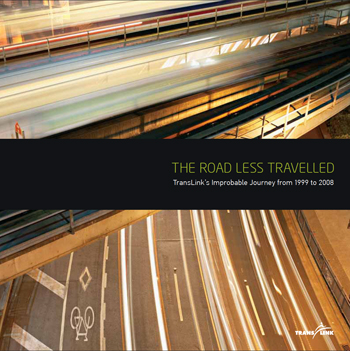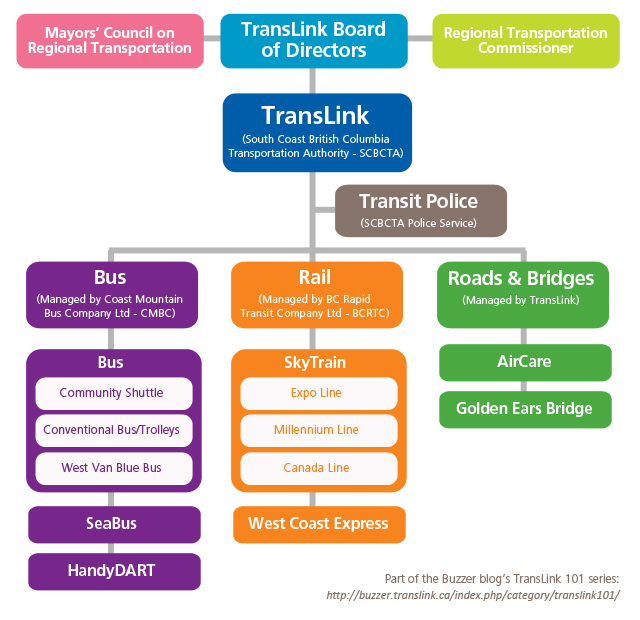TransLink 101: What is TransLink, anyway?
TransLink 101: What is TransLink, anyway?

For February 2013, we’re going back to basics with TransLink 101—a series of posts explaining TransLink and its work!
So what is TransLink, anyway?
Put simply, TransLink is the authority responsible for transportation in Metro Vancouver. And when we say transportation, we mean more than just public transit!
Our work includes:
- managing our public transit system: buses, SeaBus, SkyTrain, West Coast Express, HandyDART
- managing major roads that connect our cities, plus six bridges (Golden Ears, Knight Street, Pattullo, Westham Island, the Expo Line’s SkyBridge, and Canada Line’s North Arm Bridge)
- TravelSmart programs to encourage people to explore their travel choices: biking, walking, riding transit, carpooling, and more
- supporting cycling, through planning a regional cycling strategy and helping fund bike infrastructure like bike lockers, cycling paths like the Central Valley Greenway, maps, and more)
- AirCare vehicle emissions testing
- transportation planning and research: ongoing work to plan transportation services that achieve the goals of our region, and studies to examine options for the future
- ….and more!
The TransLink family tree
At the top, TransLink is governed by a Board of Directors, who have oversight from the Mayors’ Council on Regional Transportation, and the Regional Transportation Commissioner. For more on their specific duties and how they all relate to each other, check out our Governance Model page.
Under TransLink, a number of fully-owned subsidiary companies, and a few contractors deliver our transportation services.
Our fully-owned companies include Coast Mountain Bus Company, BC Rapid Transit Company, and AirCare. The services are contracted out include:
- The Golden Ears Bridge, operated and maintained by the Golden Crossing General Partnership
- Canada Line is operated and maintained by InTransit BC
- West Vancouver transit is planned by TransLink, but delivered by the Municipality of West Vancouver
- HandyDART transit services for those with mobility issues are run by MVT Canadian Bus Company
- A few Community Shuttle services are planned by TransLink but delivered by private contractors (Bowen Island, New Westminster).
But for more on all our operating companies and their roles, see this terrific overview on the TransLink website.
Where did TransLink come from in the first place?

The short version is that traffic and congestion in the 1990s were huge issues for the Metro Vancouver region—so the Greater Vancouver Regional District and the Province of BC worked together to create a regional agency to address transportation issues. That agency was TransLink, which launched in 1999!
TransLink was the world’s first transportation authority to run multiple modes of travel in a region. We were tasked with creating an efficient transportation network to move people and goods, in coordination with land use plans from our region’s cities.
And since we were given authority over both major roads and public transportation when we were created, TransLink is able to plan our transportation network as a strategic whole.
If you’d like the full version of TransLink’s origins, check out The Road Less Travelled, our history book from 2008. It’s got everything you need!
Is TransLink public or private?
We often hear people saying TransLink is a private agency—but in fact, we are public!
Our agency is created and governed by a provincial act, and much of our revenue comes from public funding: property taxes, fuel taxes, and more.
Our annual plans
Finally, here’s a little bit about our ongoing work that you might find helpful.
Every year, you might hear about our yearly plans in the news from time to time. That’s because by law, TransLink writes a Base Plan every year describing the transportation work we’ll engage in, including exactly how we’ll pay for it. This plan is reviewed by the Mayors’ Council and an independent Regional Transportation Commissioner, then approved by our Board of Directors.
If we want to go beyond our budget, we need to write a Supplemental Plan, outlining what we’ll do and where we’ll get the new money to pay for it. This plan is subject to review and approvals, too.
And every five years, we develop a long-range plan, asking the region for its 40-year vision to guide our annual work. Our last plan was called Transport 2040, and we’ll update it in 2013.
Questions or comments?
And that’s it for the first installment of TransLink 101! Keep an eye on the Buzzer blog in February to read more about who we are.
Feel free to share your questions and thoughts in the comments and I’ll do my best to answer them :)







When I was a kid, you gave your seat up to your elders. You used your best manners on the bus, no swearing, no loud conversations, no pushing or shoving. Seems we need to have a Miss Manners riding the bus and skytrain again! I use transit daily and am constantly stunned by the incredible rudeness displayed by other travellers!
[…] TransLink 101. The series, which was launched earlier this week and had its first installment yesterday, will be run primarily on the blog and answers some perennial questions we get about TransLink as […]
[…] What does TransLink do, anyway? […]
Eat and Drink no evil battle lost. New evils…cell phones, backpacks :) http://members.shaw.ca/dave_too2/bus/P1000640%20%282%29.JPG
I noticed that about 25% of your riders does not pay for their rides. Quite a few people uses the paper transfer tickets like a yearly pass. Many of the riders using the rear exit doors does not pay. They would also use an expired credit card that rejects their payments, all the drug addicts does not pay. If they get the red compass pass they just sell them for money. Young people do not pay, especially the ones in their twenties or thirties. If they do, they use the orange or red compass passes. The homeless people slip thru the handicapped gates or break them. Especially in downtown east side stations. Example:. A young male that can afford a $45 pie from Pie Hole, claims that he have not change for the bus because all he had were$20 bills. If you know where to buy pies, then you know that drivers do not make change. We need to stop all the free loaders by making so adjustments to the system. The paper transfer tickets is the first one. I get one and uses them for life. It is like an unlimited bus rides for free loaders. The tickets should be colour coded for each day of the week, that would simplify things. People would still cheat but it makes them work harder
Save money by changing the SkyTrain gates